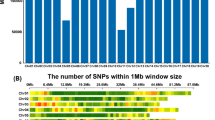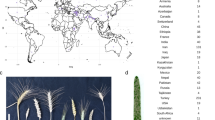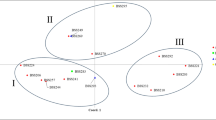Abstract
Diversity Array Technology (DArT) markers were used to investigate the genetic diversity, population structure, and extent of linkage disequilibrium (LD) on a genome-wide level in Canadian barley (Hordeum vulgare L.). Approximately 1,000 DArT markers were polymorphic and scored with high confidence among a collection of 170 barley lines composed mostly of Canadian cultivars and breeding lines. The reproducibility of DArT markers proved very high, as 99.9% of allele calls were identical among seven replicated samples. The polymorphism information content (PIC) of DArT markers ranged between 0.04 and 0.50 with an average of 0.38. Using principal coordinate analysis (PCoA), most lines fell into one of two major groups reflecting inflorescence type (two-row versus six-row). Within these two large groups, evidence of geographic clustering of genotypes was also observed. A cluster analysis Unweighted Pair Group Method with Algorithmic Mean suggested the existence of three subgroups within the two-row group and four subgroups within the six-row group. An analysis of molecular variance (AMOVA) revealed highly significant (P < 0.001) genetic variance within subgroups, among subgroups, and among groups. Values of LD, expressed as r 2, declined with increasing genetic distance, and mean values of r 2 fell below 0.2 for markers located 2.6 cM apart. Approximately 8% of marker pairs located on the same chromosome and 3.4% of pairs located on different chromosomes were in LD (r 2 > 0.2). Within both the subsets of two-row and six-row lines, LD extended slightly further (3.5 cM) than for the entire set, while 7.5% of intra-chromosomal locus pairs and <2% of inter-chromosomal pairs were in LD. We discuss the implications of these findings with regard to the prospects of association mapping of complex traits in barley.



Similar content being viewed by others
Notes
Due to variation in map lengths from different sources, total map distances were estimated as the average map lengths based on all maps presented at ‘Plant Genome Central’, NCBI (http://www.ncbi.nlm.nih.gov/genomes/PLANTS/PlantList.html) as of 2009-Feb-02.
Estimated genome sizes were obtained from ‘Plant Genome Central’ at NCBI (http://www.ncbi.nlm.nih.gov/genomes/PLANTS/PlantList.html) as of 2009-Feb-02.
References
Bao YP, Huber M, Wei TF, Marla SS, Storhoff JJ, Müller UR (2005) SNP identification in unamplified human genomic DNA with gold nanoparticle probes. Nucleic Acids Res 33(2):e15
Botstein D, White RL, Skolnick M, Davis RW (1980) Construction of a genetic linkage map in man using restriction fragment length polymorphisms. Am J Hum Genet 32:314–331
Caldwell KS, Russell J, Langridge P, Powell W (2006) Extreme population-dependent linkage disequilibrium detected in an inbreeding plant species, Hordeum vulgare. Genetics 172:557–567
Felsenstein J (1985) Confidence-limits on phylogenies—an approach using the bootstrap. Evolution 39:783–791
Flint-Garcia SA, Thornsberry JM, Buckler ES (2003) Structure of linkage disequilibrium in plants. Annu Rev Plant Biol 54:357–374
Hayes P, Szucs P (2006) Disequilibrium and association in barley: thinking outside the glass. Proc Natl Acad USA 103(49):18385–18386
Hill WG, Robertson A (1968) The effects of inbreeding at loci with heterozygote advantage. Genetics 60(3):615–628
Hill WG, Weir BS (1988) Variances and covariances of squared linkage disequilibria in finite populations. Theor Popul Biol 33(1):54–78
Iwata H, Uga Y, Yoshioka Y, Ebana K, Hayashi T (2007) Bayesian association mapping of multiple quantitative trait loci and its application to the analysis of genetic variation among Oryza sativa L. germplasms. Theor Appl Genet 114:1437–1449
Jaccoud D, Peng K, Feinstein D, Kilian A (2001) Diversity arrays: a solid state technology for sequence information independent genotyping. Nucleic Acids Res 29:e25
Jander G, Norris SR, Rounsley SD, Bush DF, Levin IM, Last RL (2002) Arabidopsis map-based cloning in the post-genome era. Plant Physiol 129:440–450
Kraakman ATW, Niks RE, Van den Berg PMMM, Stam P, Van Eeuwijk FA (2004) Linkage disequilibrium mapping of yield and yield stability in modern spring barley cultivars. Genetics 168:345–446
Maliysheva-Otto LV, Ganal MW, Roder MS (2006) Analysis of molecular diversity, population structure and linkage disequilibrium in a worldwide survey of cultivated barley germplasm (Hordeum vulgare L.). BMC Genet 7:1–14
Nei M, Li W (1979) Mathematical model for studying genetic variation in terms of restriction endonuleases. Proc Natl Acad USA 76:5269–5273
Nordborg M, Borevitz JO, Bergelson J, Berry CC, Chory J, Hagenblad J, Kreitman M, Maloof JN, Noyes T, Oefner PJ, Stahl EA, Weigel D (2002) The extent of linkage disequilibrium in Arabidopsis thaliana. Nat Genet 30:190–193
Remington DL, Thornsberry JM, Matsuoka Y, Wilson LM, Whitt SR, Doebley J, Kresovich S, Goodman MM, Buckler ES (2001) Structure of linkage disequilibrium and phenotypic associations in the maize genome. Proc Natl Acad USA 98(20):11479–11484
Rostoks N, Ramsay L, MacKenzie K, Cardle L, Bhat PR (2006) Recent history of artificial outcrossing facilitates whole-genome association mapping in elite inbred crop varieties. Proc Natl Acad USA 103(49):18656–18661
Russell J, Booth A, Fuller J, Harrower B, Hedley P, Machray G, Powell W (2004) A comparison of sequence-based polymorphism and haplotype content in transcribed and anonymous regions of the barley genome. Genome 47(2):389–398
Swofford DL (2003) PAUP*. Phylogenetic analysis using parsimony (*and other methods), vol 4. Sinauer Associates, Sunderland, MA
Tinker NA, Kilian A, Wight CP, Heller-Uszynska K, Wenzl P, Rines HW, Bjornstad A, Howarth CJ, Jannink JL, Anderson JM, Rossnagel BG, Stuthman DD, Sorrells ME, Jackson EW, Tuvesson S, Kolb FL, Olsson O, Federizzi LC, Carson ML, Ohm HH, Molnar SJ, Scoles GJ, Eckstein PE, Bonman JM, Ceplitis A, Langdon T (2009) New DArT markers for oat provide enhanced map coverage and global germplasm characterization. BMC Genom 10:39
Weir BS, Hill WG (1986) Nonuniform recombination within the human beta-globin gene cluster. Am J Hum Genet 38(5):776–781
Wenzl P, Carling J, Kudrna D, Jaccoud D, Huttner E, Kleinhofs A, Kilian A (2004) Diversity Arrays Technology (DArT) for whole-genome profiling of barley. Proc Natl Acad Sci USA 101(26):9915–9920
Wenzl P, Li H, Carling J, Zhou M, Raman H, Paul E, Hearnden P, Maier C, Xia L, Caig V, Ovesna J, Cakir M, Poulsen D, Wang J, Raman R, Smith KP, Muehlbauer GJ, Chalmers KJ, Kleinhofs A, Huttner E, Kilian A (2006) A high-density consensus map of barley linking DArT markers to SSR, RFLP and STS loci and agricultural traits. BMC Genom 7:206
Author information
Authors and Affiliations
Corresponding author
Additional information
Communicated by J.-L. Jannink.
Rights and permissions
About this article
Cite this article
Zhang, L.Y., Marchand, S., Tinker, N.A. et al. Population structure and linkage disequilibrium in barley assessed by DArT markers. Theor Appl Genet 119, 43–52 (2009). https://doi.org/10.1007/s00122-009-1015-4
Received:
Accepted:
Published:
Issue Date:
DOI: https://doi.org/10.1007/s00122-009-1015-4




